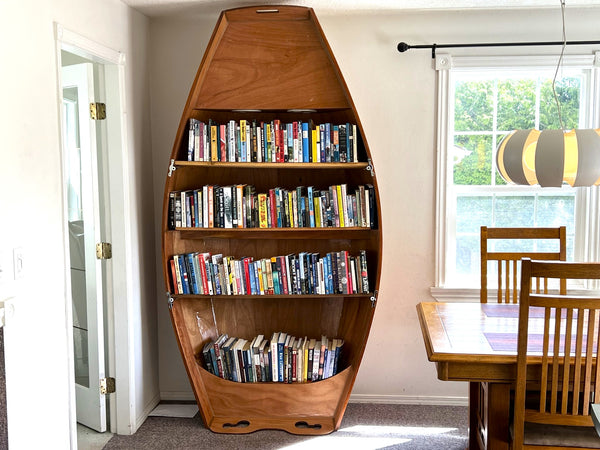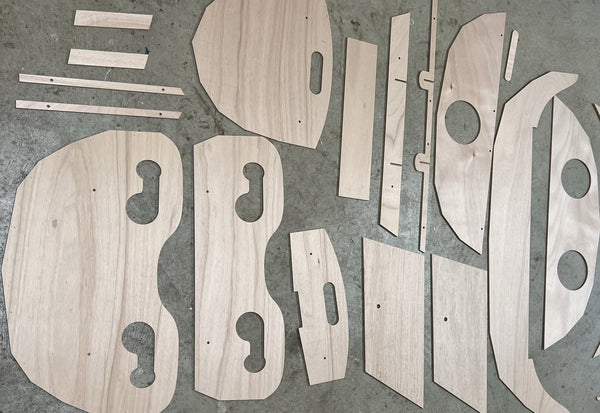Hollow Shaft Wooden Sculling Oar Progress
For those who have been waiting for our hollow-shaft wooden sculling oar plans, we’re pleased to inform you we’re nearing completion. We’ve been simultaneously working on a build video, manual, plans and the final version of oars that we’ve developed. It’s been an interesting experience, and our objective was to transform a process that is often described as a complex art into a step by step process that any intermediate builder can complete.
Construction of the shafts is a relatively simple (albeit precise) process. Four 10-foot-long strips of wood of varying thickness and width are ripped from clean knot-free stock of spruce (or similar wood). These are glued together creating a long rectangular-ish box which is further shaped and contoured. Several blocks of wood are then laminated to the end of the shaft creating a large rectangular block that the blade is carved from.
It is the sculpting of the blade that is the greatest challenge. Most people are not skilled carvers, and the shape of a fine-crafted sculling blade is very elaborate. Our objective was to create a foolproof system using templates and straightforward instructions allowing non-artistic first-time carvers to make a perfect blade. We fine tuned the shape of the blade so it is both functional and beautiful while being as easy as possible to replicate with basic carving tools.
When researching the subject of constructing hollow shaft sculling oars, the information we found was often very daunting. Complex and hard-to-find tools such as convex-shaped planes, spokeshaves, drawknives and expensive band saws were usually listed as necessities. It seemed carving expertise and a draftsman-like prowess for transferring line drawings was also required.
We feel we have been successful in simplifying the process to the point where almost anyone can make a fine set of sculling blades. To emphasize this, we constructed our final set of oars (the ones that are featured in our upcoming build video) with the most basic of tools and materials. The wood is cut from a few ten foot spruce 2x4s picked up from Home Depot (yes, we did have to sort through several hundred pieces before finding the perfect straight-grained knot-free specimens required), and we purposely used old low quality tools that would be found in most basic shops. The fanciest piece of equipment used was an old $100 table saw. The only carving tools used were a handsaw, a half-inch low-quality chisel, utility knife, a $14 block plane and a random orbital sander. Not everyone wants to spend a fortune for a one-time project, so we wanted to make sure it could be done easily with the basics. The results, however, look like something suitable for taking royalty down the Thames. Of course, if you have more specialized tools, the job will be even easier.
It’s a significant time commitment building your own wooden sculling oars (25-40 hours), however, the savings are substantial. Composite oars cost $500-$700, while materials for building your own are $50-$100. More importantly, the finished product is infinitely more beautiful than a pair of mass-produced carbon-fiber oars. If you’ve spent the time creating a beautiful wooden rowing craft with a sliding seat system, it’s well worth spending the time to create a matching set of gleaming wooden oars.
The biggest question, of course, is performance. If you have a sliding seat rowing system, you simply cannot use standard off-the-shelf wooden oars designed for fixed seat rowing. The oars need to be long, light and shaped at the collar so they feather in the oarlocks with a twitch of the hands. Our sculling oars tick all these boxes. They are only a little heavier than carbon fiber (we’ll provide the precise specs soon), and all other aspects are the same. Plans and details will be available in 2-3 weeks.
Row for Autism
 In other news, one of our customers, John Carinha is currently finishing off his Expedition Rowboat which he plans to circumnavigate Vancouver Island in. The purpose of his journey is to raise funds and awareness for a couple of great organizations, Canucks Autism Network and Autism Community Training, and you can learn more about his expedition at http://proceansports.wordpress.com/. John just sent me a picture of his freshly painted boat, and his creative finishing design is almost as impressive as his huge efforts to raise awareness for a condition that affects almost one percent of North Americans. Good luck, John!
In other news, one of our customers, John Carinha is currently finishing off his Expedition Rowboat which he plans to circumnavigate Vancouver Island in. The purpose of his journey is to raise funds and awareness for a couple of great organizations, Canucks Autism Network and Autism Community Training, and you can learn more about his expedition at http://proceansports.wordpress.com/. John just sent me a picture of his freshly painted boat, and his creative finishing design is almost as impressive as his huge efforts to raise awareness for a condition that affects almost one percent of North Americans. Good luck, John!
2 Responses
Dean nelson
I’m interested in building the hollow core sculling oars, but would prefer to work from measurements( shop drawings) as opposed to tracing. Seems tedious and inaccurate. Could you let me know if this is possible?
Laurence McKinley
Looking forward to the Sculling Oars plans and kits.. .I’ ve made inexpensive oars in the past.. I glued two pieces of marine plywood shaped like the blade I wanted. I placed them overnight in a jig I made up,in the vice of my workbench to give the blades their longiludinal camber. The surfaces are epoxied together The results aren’t bad, very strong .Ply is 3/16 or 1/4 inch all you need to do then is fit them to the loom of the oar.. A block of wood about 1 1/2 ins on a 22inch long blade gives a nice camber
Leave a comment
Comments will be approved before showing up.
Also in News

Human Powered Achievements through the Northwest Passage
At Angus Rowboats, our passion for adventure naturally draws us to the mystique of the Northwest Passage – one of the world's most captivating and perilous waterways. Historically, this elusive passage promised a shorter shipping route, spurring early navigators to fervently chart and struggle through its icy intricacies.
The summer of 2023 saw three audacious teams, including one using our very own RowCruiser boats, aiming to be the first to traverse NW Passage solely by human power within a single season. As the season concludes, we've chronicled these attempts, and catalogued past human-powered endeavors to navigate the Northwest Passage.

Creating a Bookcase from a Boat


Angus Rowboats
Author